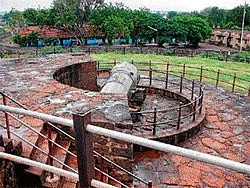A visit to the city of monuments is an experience of a lifetime. Bijapur is full of many majestic structures, remains of a rich past, which narrate many interesting stories.

A case in point is Malik-e-Maidan (king of the battlefield), the biggest gun used by Adil Shahi kings. Placed on the bastion of the fort between the Mekka and Shahapur gates, the famous Malik-e-Maidan is made of bell metal or a similar alloy.
It is more like a huge French howitzer, with a great thick cylinder with a calibre very large in proportion to its length, and which spreads slightly from the breech to the muzzle, allowing a very great amount of windage.
There are three inscriptions on its top, one giving the name of the man who made it (Muhammad bin Hasan, E-umi); another giving the date of its casting (AH 956) with the name of Abul Ghazi Nizam Shah, and the third, a later inscription which was added by Aurangzeb when he conquered Bijapur in AH 1097 (AD 1685-86), embossing details of his victory on it.
Auctioned for just Rs 150!
The 55-tonne-cannon was cast at Ahmednagar in Maharashtra during the 15th century. According to historians, this 14-ft-long and about four-ft-wide gun had caused considerable damage to the Vijayanagar army in the battle of Talikota. After the decisive Talikota battle in which Deccan Sultans defeated Vijayanagar kings, the gun was mounted on the hill fort of Parandah (in Maharashtra), one of Ahmednagar Sultan Nizam Shah’s strongholds, situated about 160 km north of Bijapur.
But when Adil Shahi kings defeated Ahmednagar Sultans and conquered this town in 1632, the gun was brought to Bijapur as a war trophy by Adil Shahi kings. Ironically, once known as the king of the battlefield, this grand gun was about to meet a tragic end in 1854. But it survived because of a mamaledar (revenue officer), who had love and respect for historical artefacts.
About that year, the Satara commissioner (Bijapur was under the revenue jurisdiction of Satara Province during British regime) ordered the sale of dead stock lying in Bijapur, and the mamaledar acting upon the orders of the commissioner, put up the cannon for auction! The highest bid for this mass of metal was just Rs 150.
The mamaledar, considering this very little for so much material, reported the bid to the assistant commissioner and informed the officer that the gun was held in high regard by people far and wide and therefore it was better to preserve it.
Hearing this, the assistant commissioner declared the auction null-and-void, and directed that the gun be retained. Later, a proposal was made to transport the gun to the British Museum, but fate wisely ordered otherwise, and it still remains on the walls it protected once upon a time.
“Like all other guns, it has been dismounted and its carriage has been taken away. From the manner in which these dismounted guns have been carefully placed on huge timbers, it appears that the enemy force, after capturing the city, (perhaps Aurangzeb when he finally conquered Bijapur), carried away the carriages with the intention of bringing them back for the conqueror’s own use should he have occasion again to return to Bijapur. But he never came back to Bijapur. In the meantime, the guns would be next to useless without them,” explains historian Henry Cousens in his book on Adil Shahi dynasty.
